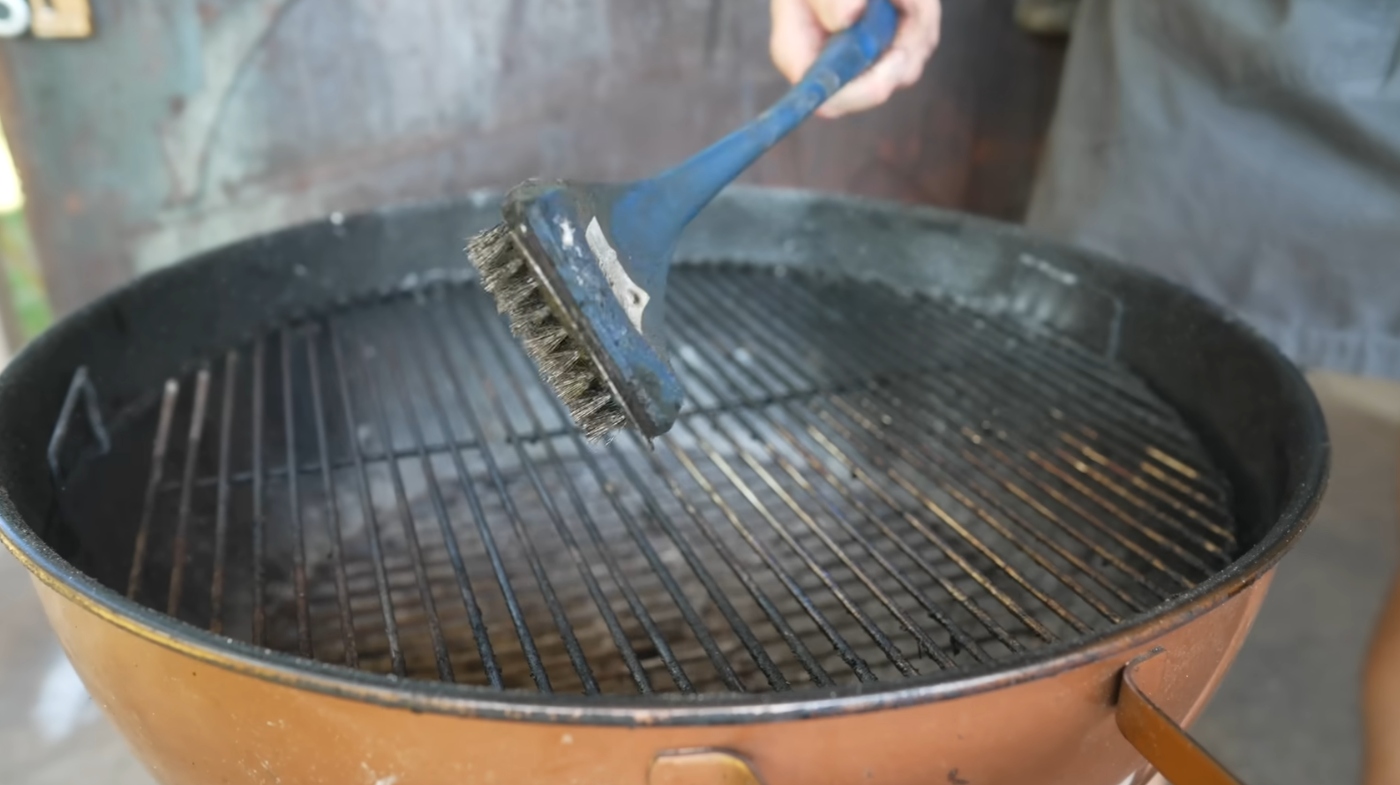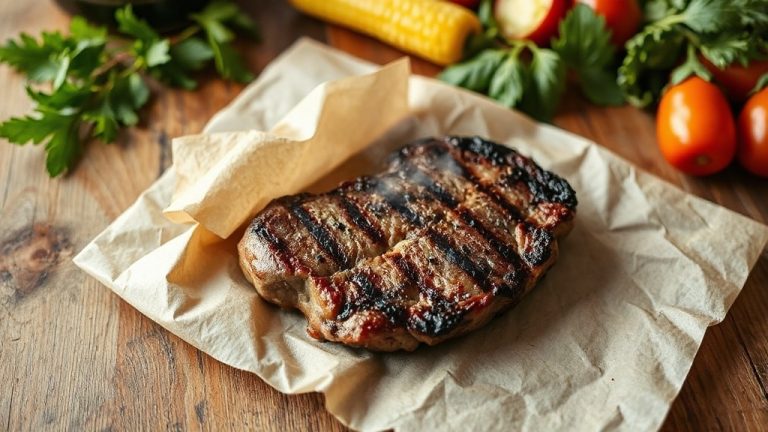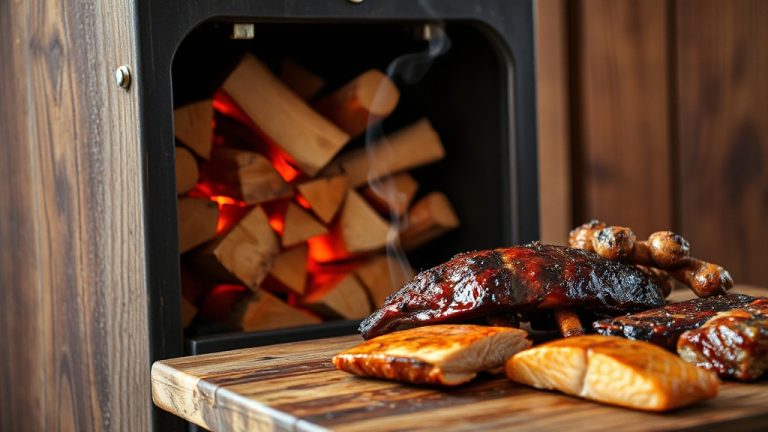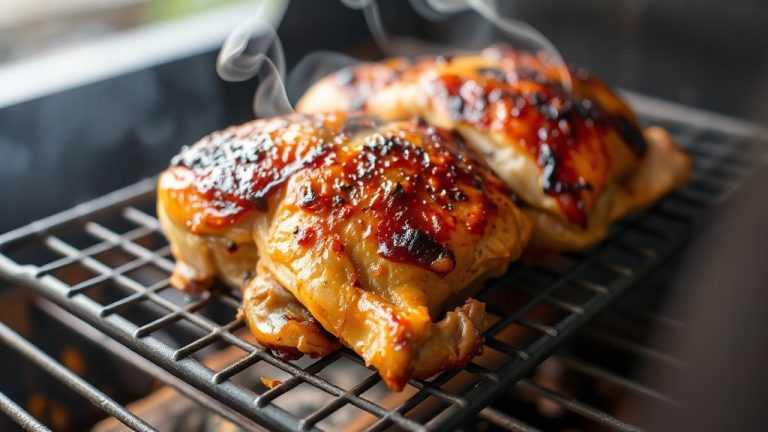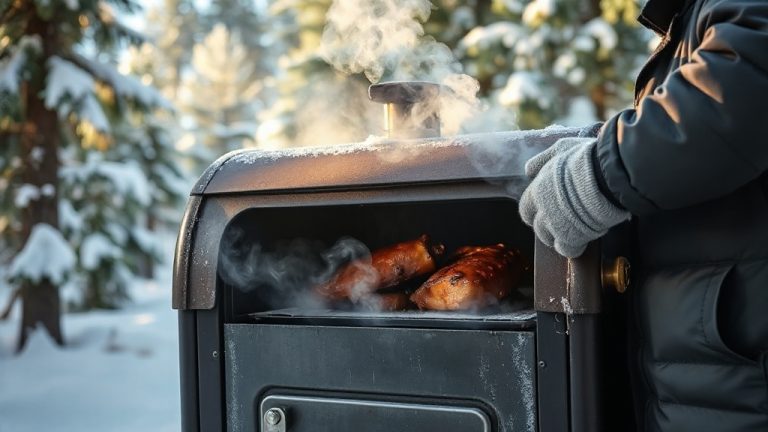How to Clean Mold Off Grill? Easy Steps for Safe Cooking
To clean mold off your grill, start by wearing waterproof gloves, a mask, and eye protection. Remove grates and porous materials like charcoal, then heat the grill to 600°F for 30 minutes to kill spores.
After cooling slightly, scrub grates and covers with a grill brush and mild detergent outdoors. Rinse and dry thoroughly, then apply a grill-safe cleaner if needed.
Store your grill in a dry, ventilated spot with a breathable cover. For detailed steps and tips, keep exploring these proven methods.
Key Takeaways
- Identify mold by greenish-black or white patches and musty odors, especially inside grills exposed to moisture or poor ventilation.
- Wear waterproof gloves, N-95 mask, eye protection, and clean the grill outdoors with good airflow to avoid inhaling mold spores.
- Remove grates and porous materials, preheat grill to 600°F–650°F for 30–60 minutes to kill spores before manual scrubbing with a grill brush.
- Clean thoroughly with grill-safe cleaners, rinse well, and avoid bleach; dry completely to prevent moisture buildup and mold regrowth.
- Store grill in a dry, ventilated area with breathable covers, clean regularly, and maintain high heat to prevent future mold growth.
Recognizing Mold on Grill Surfaces
When you inspect your grill, keep an eye out for greenish-black or white patches, as these often signal mold growth on the surfaces.
Focus on interior areas with poor ventilation, since mold thrives there, especially after rain or in high humidity. Check for unusual discolorations or a musty odor, common indicators of mold presence.
Rain exposure can increase moisture levels, creating ideal conditions for mold to develop. Mold growth is influenced by factors such as humidity, residual food particles, and sealing ability.
To confirm, try applying a small amount of bleach; mold typically won’t disappear immediately. Remember, all grill types—including Green Egg and charcoal models—can develop mold if moisture lingers.
Regularly inspect and clean your grill after use to reduce mold risk. Maintain good airflow around the grill and store it in dry, ventilated locations.
Using a waterproof cover helps prevent moisture buildup and protects your grill from rain damage. If you’re uncertain about mold, consider professional inspection or use a mold sampling kit for accurate identification.
Causes of Mold Growth on Grills
Spotting mold on your grill is just the first step; understanding what causes it helps you prevent it effectively.
Mold thrives where moisture lingers—humid climates, rain exposure, or grills stored in covered patios or garages without proper airflow. Proper temperature control can also inhibit mold growth by reducing dampness.
If you don’t dry your grill fully before covering or storing it, trapped moisture creates a perfect breeding ground. Leftover food residue and grease feed mold spores, so skipping thorough cleaning after use invites growth.
Uncleaned grills hinder proper inspection and timely repairs, allowing issues like rust formation to develop unnoticed.
Also, storing your grill with the lid closed or using non-breathable covers traps humidity inside. To minimize mold, clean your grill diligently after each cook, ensure it’s dry before covering, and store it in a well-ventilated area.
Preparing for Safe Mold Removal
Before you start cleaning mold off your grill, make sure you equip yourself with the right personal protective equipment (PPE) to stay safe. This includes waterproof gloves, an N-95 mask or respirator, old clothes or washable protective wear, and eye protection.
Next, prepare your cleaning area properly by working outdoors in a well-ventilated space and opening the grill lid to air out mold spores. Mold thrives in damp, warm, dark environments like grills, so airing it out helps reduce spore concentration.
Remove any porous materials inside the grill, like charcoal, which can harbor mold. Finally, have all cleaning tools and supplies ready, such as mild detergent, brushes, and cloths.
Heat Treatment to Eliminate Mold Spores
To effectively eliminate mold spores on your grill, maintain temperatures between 600°F and 650°F for 30 to 60 minutes. This temperature range is ideal because it corresponds to the slow burn rate of hardwoods like oak, which effectively sterilizes surfaces.
Always preheat the grill gradually and keep vents sealed to hold consistent heat without damaging the equipment. Use heat-resistant tools and work outdoors to stay safe during the treatment process. However, scrubbing is necessary to remove mold residues after heating to avoid exposure to mold toxins.
Optimal Temperature Settings
When you heat your grill to temperatures between 450°F and 700°F, you effectively kill mold spores and loosen stubborn debris.
To optimize this process, follow these steps:
- Preheat your grill to at least 450°F, aiming for up to 700°F if your grill allows. Using an insulated grill or adding a fire-resistant blanket can help maintain these high temperatures more efficiently.
- Ensure proper ventilation and wear protective gloves and an N-95 mask to avoid inhaling spores.
- Remove ash and charcoal beforehand to maintain good airflow, which helps reach and sustain high temperatures. Proper airflow is crucial to prevent recurrent mold problems during and after cleaning.
- Use this heat treatment regularly, especially in humid areas, to prevent mold growth and make cleaning easier. Keeping your grill sheltered from wind and moisture also aids in reducing mold development.
Duration for Effective Burn
Although reaching the right temperature is crucial, you also need to maintain the heat for an effective duration to eliminate mold spores on your grill.
Aim to burn your grill at around 500°F for 15 to 20 minutes. This sustained heat kills most mold spores and helps loosen debris for easier cleaning.
Shorter burns mightn’t be enough to fully remove embedded mold. Keep the heat steady throughout the period, but monitor carefully to prevent fire hazards.
Achieving and maintaining such high temperatures is important because mold dies at temperatures between 140-160°F.
If you use lower temperatures, know that you’ll need much longer exposure times, often 15 to 30 minutes, combined with moisture for effective mold kill.
Sticking to these durations ensures thorough mold elimination while balancing safety and effectiveness during your grill cleaning process. Using indirect heat during the process can help prevent damage to grill components while ensuring even temperature distribution.
Safety During Heat Treatment
Maintaining high heat on your grill to kill mold spores can release harmful particles and toxins into the air. To stay safe during heat treatment, follow these essential steps:
- Heat your grill only outdoors in a well-ventilated area to prevent smoke buildup. This method is similar to techniques used to enhance smoky flavor in BBQ sauces through controlled heat exposure.
- Wear protective gear—gloves, goggles, and a respirator mask—to avoid inhaling toxic fumes.
- Remove any flammable or combustible materials nearby to reduce fire risks.
- Keep a safe distance from smoke and fumes to protect your respiratory system, as warming leftover debris can release harmful odors and particles.
Manual Cleaning Techniques for Grill Grates and Covers
Before you start scrubbing, remove the grill grates and covers to access all surfaces fully and inspect for mold or buildup.
Remove grates and covers first to fully access and check for mold or buildup before scrubbing.
Heat the grill first to loosen residues, then let the grates cool to a warm, safe-to-touch temperature.
Use a high-quality grill brush or crumpled aluminum foil to scrape along the grate grooves, applying firm but careful pressure to avoid damage. This helps reduce rust buildup by removing food particles and moisture that promote corrosion.
For covers and removable parts, wash them with warm, soapy water using a sponge or cloth to reach mold spots and grease. Using materials that are food-grade safe ensures no harmful residues remain after cleaning.
Rinse thoroughly and dry completely to prevent moisture retention. Regular manual cleaning after each use helps stop mold growth early.
Always ensure parts are dry before reassembly and storage to keep your grill mold-free and safe for your next cookout.
Using Chemical Cleaners Safely and Effectively
When tackling mold on your grill with chemical cleaners, you need to prioritize safety and follow proper application methods to get the best results.
First, always wear waterproof gloves and work outdoors or in a well-ventilated area to avoid harmful fumes. Proper ventilation is crucial to reduce exposure to volatile organic compounds.
Next, apply grill-specific cleaners liberally on moldy spots and let them sit for 10–15 minutes to break down mold and grease. It is also important to choose cleaners that are surface compatible with your grill material to avoid damage.
Then, use small brushes to scrub crevices gently, ensuring the cleaner penetrates deeply. Finally, rinse your grill thoroughly with water to remove all chemical residues before using heat to sanitize.
Remember never to mix cleaners and avoid bleach on food-contact surfaces, opting for products labeled safe for grills to protect both your health and your equipment.
Protective Measures During Mold Cleanup
Chemical cleaners help break down mold effectively, but handling mold cleanup requires more than just the right products.
You should wear waterproof gloves, a mold-rated mask, safety goggles, and long-sleeve clothing to protect your skin, eyes, and lungs. Using appropriate protective gear also helps reduce exposure to harmful compounds that mold may release.
Use waterproof gloves, mold-rated masks, goggles, and long sleeves to safely protect yourself during mold cleanup.
Avoid dry brushing to prevent mold spores from becoming airborne; instead, use wet cleaning methods. Work outdoors or in a well-ventilated area, using fans or open windows to improve airflow. Good ventilation is crucial because limited airflow traps moisture and fosters mold growth.
Dispose of porous materials like charcoal or sponges that can’t be cleaned thoroughly. Place used cloths and gloves in sealed plastic bags to avoid spreading mold.
After cleaning, wash reusable tools in hot soapy water. Don’t mix chemical cleaners, and avoid eating or drinking during cleanup to reduce health risks.
Preventative Practices to Avoid Future Mold Development
To keep mold from returning, you need to manage moisture around your grill carefully. Follow these key steps:
- Store your grill in a dry, well-ventilated area and keep vents open after use to promote airflow and drying. Use a breathable cover if outdoors, avoiding sealed covers that trap moisture. Poor air circulation contributes significantly to mold growth, so ensuring good airflow is essential. Proper temperature management during use can also reduce lingering moisture on grill surfaces.
- Clean thoroughly after each use by burning off food residue at high heat, scraping grease, and washing with mild detergent. Always dry completely before covering or storing. Incorporating medium-high heat searing techniques not only cooks food properly but helps kill mold spores effectively.
- Prevent grease buildup by regularly cleaning grates, grease trays, and drip pans. Replace absorbent materials like charcoal or wood chips after use.
- Inspect your grill monthly for mold, rust, or damaged seals. Replace worn parts promptly to maintain proper ventilation and protect against moisture. Regular maintenance and cleaning after frequent use help prevent mold buildup effectively. The use of cast iron or two-zone grilling setups can improve heat distribution and reduce residue that promotes mold growth.
Frequently Asked Questions
Can Mold on Grill Grates Cause Food Poisoning?
Yes, mold on grill grates can cause food poisoning. When you cook on moldy grates, harmful microbes and toxins may transfer to your food, leading to digestive issues like vomiting or diarrhea.
To keep safe, always clean your grates thoroughly, preheat the grill to burn off residues, and store it in a dry place. Don’t ignore mold—it’s a real health risk you can prevent with proper grill care.
How Often Should I Replace My Grill Grates Due to Mold Damage?
You mightn’t realize when it’s time to replace your grill grates—until mold and damage become serious. If you spot deep rust, persistent mold, or cracking that cleaning can’t fix, it’s time.
For regular grillers, check grates every season and expect to replace them every 3 to 5 years. Don’t risk contamination; maintain a strict cleaning routine and dry grates thoroughly to extend their safe lifespan.
Is It Safe to Use a Pressure Washer to Clean Mold From Grills?
You can safely use a pressure washer on your grill if you take precautions. Disconnect propane tanks and cover gas connections to avoid water damage.
Use around 1000 PSI with a 15- or 25-degree nozzle, keeping distance from knobs and igniters. Remove grates and burners first, scrape off debris, and pressure wash carefully to prevent damage.
Always wear gloves and safety glasses, and dry parts thoroughly before reassembling to stop mold regrowth.
Can Mold Develop Inside the Grill’S Gas Lines or Burners?
Mold rarely develops inside your grill’s gas lines because they’re sealed and lack moisture. However, mold can grow on burners if you leave food residue or moisture inside.
To prevent this, always clean burners thoroughly, clear burner holes with a thin tool, and run your grill at high heat for 15-20 minutes to kill spores. Regularly inspect gas line fittings too, keeping them dry to avoid mold around connections.
Are Electric Grills Less Prone to Mold Than Charcoal Grills?
Yes, electric grills are less prone to mold than charcoal grills. You’ll find electric grills have enclosed designs and fewer porous parts, which reduce moisture buildup. They dry faster and are easier to clean, so mold has less chance to grow.
Charcoal grills trap moisture in ash and porous surfaces, increasing mold risk. To stay safe, clean your grill regularly, dry it thoroughly, and store it in a dry, sheltered spot.
Grill Clean, Grill Safe: Keep Mold Away for Good
Cleaning mold off your grill is like giving your outdoor cooking space a fresh start. By spotting mold early, using heat and manual scrubbing, and applying safe chemical cleaners, you protect your health and your grill’s lifespan.
Always wear gloves and a mask to stay safe. With regular maintenance and proper storage, you’ll keep mold from coming back. Follow these steps, and your grill will be ready for many delicious meals ahead.
